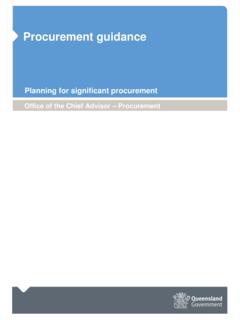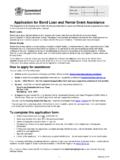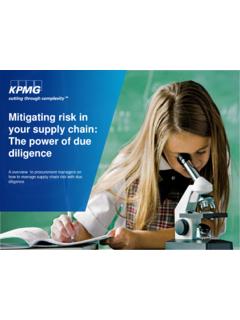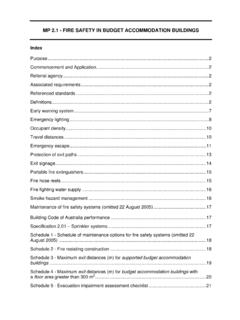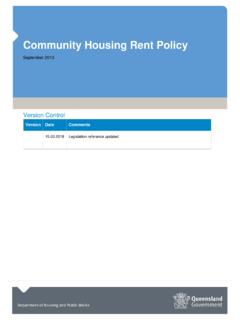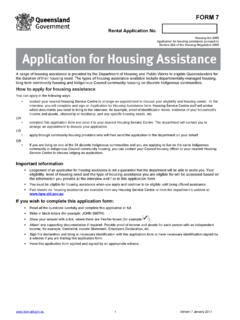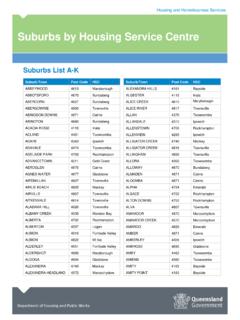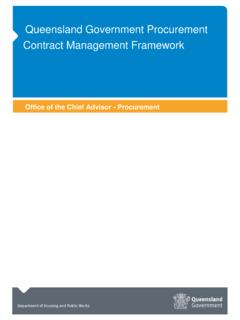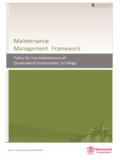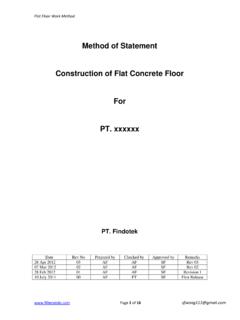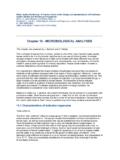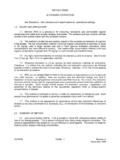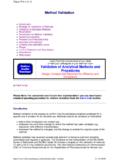Transcription of Guidance on evaluating tenders using Price Quality …
1 Contract Services Department of Public Works Guidance on evaluating tenders using Price Quality Method For assessment of tenders under non-traditional procurement The Capital Works Management Framework guideline Contractor PQC: Tendering and Selection Process contains a guide as to the minimum value of the Price criterion applicable to government building projects. It does not stipulate a methodology for evaluating tenders where Price and non- Price criteria are included in the tender documents. This Guidance note details the Price Quality Method (a tender evaluation methodology used to assist agencies undertaking this function for non-traditional projects) and whilst not mandatory, is the preferred methodology for assessing tenders using non-traditional contract forms. Applying the Price Quality Method (PQM) What is the Price Quality Method (PQM)? The Price Quality Method (PQM) of evaluating tenders for building contracts is derived from a system used successfully in New Zealand and other countries by government authorities and aims to establish better value for money in the tender assessment process.
2 It provides a method to evaluate non-traditional tenders based on the Price and the non- Price aspects of the tender, and seeks to identify the tender representing the best value for money. Unlike strict formula 1 models where Price and non- Price aspects of a tender are scored and added together, the PQM establishes in monetary terms the Quality premium or notional value assigned to each tender compared to the tender with the lowest non- Price criteria score (note, not the lowest tender Price ). This is achieved by first scoring the tendered non- Price criteria and calculating a dollar value for the non- Price criteria to establish the Quality premium'. The Quality premium is then apportioned to each of the tenders according to their non- Price criteria scores and, for the purpose of tender evaluation only, the apportioned value is deducted from each of the tender sums.
3 The tenderer with the lowest score for non- Price criteria gets no Quality premium deduction, while other tenderers receive Quality premium deductions relative to their score for non- Price criteria (refer Appendix 1). 1. Formula models usually reduce the Price to a score and then add it to the non- Price criteria score. Guidance on evaluating tenders using Prive Quality Method Page 2 of 7 The PQM attempts to quantify how much one might pay for potentially better Quality ' over 'adequate Quality ' represented by the tenderer with the lowest non- Price criteria score. Hows does PQM work? As stated above, the PQM calculates a dollar value for the non- Price criteria score of each tenderer, which is deducted from each tenderer's tender Price to establish a final ranking of the tenders . Out of a total possible amount of 100 points, the non- Price criteria is recommended to be assigned a score ranging between 10 and 40 points (see PQM weightings below).
4 The Tender Evaluation Panel s initial task is to score each tenderer s non- Price criteria submission. The tenderers tender sums are not disclosed to the Panel at this time. Each Price criteria is scored out of 5 (or any usual scale, eg could be out of 100) as per the normal tender evaluation process. For example, a tenderer s score for say a criterion such as organisational performance may be 4 out of a possible 5 points. Each tenderer's non- Price score is entered into the evaluation spreadsheet and is totalled. Once this has been completed, each tenderer s tender sum can be revealed to the Tender Evaluation Panel and entered into the spreadsheet. The difference is calculated between the tenderer with the lowest total non Price criteria score and all other tenderers' non- Price criteria scores. This difference is used to establish the Quality premium advantage in dollar terms that each tenderer gets over the tenderer with the lowest non- Price criteria score.
5 The PQM tender evaluation methodology uses non- Price criteria recommended to be a total of between 10 to 40 points. It is important to note that this does not mean for example in the case of 40 points non- Price , that the tender evaluation is 40 percent non- Price and 60 percent Price . It is not a percentage based assessment. Rather, the PQM uses a formula to calculate the Quality premium, which is then used as a basis to establish a final ranking of the tenders . The Quality premium calculation is: Tender Estimate x Weighted Sum Margin Price Weight Tender Estimate is the tender estimate determined prior to the opening of tenders . Weighted Sum Margin is the total of the scores for each tenderer's response to the non- Price criteria, less the lowest non- Price criteria score ( the amount above the lowest tenderer's total score for non- Price criteria).
6 The Weighted Sum Margin for each tenderer is calculated as follows: Weighted Sum Margin = Weighted Sum minus the lowest Weighted Sum score of the tenderers Weighted Sum = the sum of the Index values Index value = Grade x Weight 5 (score range) Grade = score Weight = points for the non- Price criterion Contract Services January 2012 Guidance on evaluating tenders using Prive Quality Method Page 3 of 7 Price Weight is calculated by deducting from 100 the total of the non- Price criteria points. For example, if the non- Price criteria are given a total weighting of 30 points then the Price Weight (the denominator in the formula) in the calculation will be 70. The higher the Price weight, the lower the Quality premium; the greater the difference in non- Price criteria scores, the higher the Quality premium. Each tenderer's Quality premium is calculated and then deducted from that tenderer's tendered Price for the purposes of ranking the tenders .
7 The lowest tender amount after adjustment for the Quality premium becomes the highest ranked or preferred tenderer. See Appendix 1 for a worked example of the PQM tender evaluation methodology. PQM Weightings As stated above, the use of the PQM tender evaluation methodology should only be applied to non-traditional contracts. The scoring of non- Price criteria is recommended to be out of 5 to ensure consistency in application (refer to the Scale of Scores' in Appendix 2). Any score lower than (ie 50% of the total score of any criterion) may result in the tenderer not being considered further, provided that the conditions of tender give this discretion to the Principal. The Department of Public Works is available to provide Guidance on appropriate non- Price criteria and their weightings for particular projects. Under Policy Requirement 10 of the Capital Works Management Framework, for High Risk/Significant projects agencies.
8 Consult with the Department of Public Works on the proposed evaluation to be used for the selection prior to calling tenders . The non- Price criteria for Managing Contractor contracts should typically range from 20 points for projects with low complexity and an advanced design, to 30 or possibly 40 points non- Price criteria for highly complex projects where the project is less defined. Non- Price criteria points for Lump Sum Design and Construct contracts should typically range from 10 to 20 points similarly with respect to complexity and how well defined the project requirements are. This will ensure an appropriate balance between the Quality premium and cost factors. SUGGESTED NON- Price CRITERIA POINTS FOR PQM Type of Non-Traditional Contract Total Number of Points LUMP SUM Design and Construct Standard Complexity ( school) 10 Higher Complexity ( office /other building) 20 MANAGING CONTRACTOR Standard complexity ( Govt Office Building well advanced) 20 High Complexity ( Hospital very preliminary design) 30-40 Contract Services January 2012 Guidance on evaluating tenders using Prive Quality Method Page 4 of 7 Consideration should be given to the Quality premium that government agencies may be prepared to pay to achieve the better outcomes identified in the non- Price criteria.
9 To assist this process, prior to undertaking the tender process, sensitivity analyses can be carried out in conjunction with establishing the appropriate non- Price criteria and points, to calculate the likely value of Quality premiums and to discuss with the relevant members of the project team and Tender Evaluation Panel prior to going to tender. As the range of scores will generally be between 2 and 5 out of 5 for each of the criteria (where this scoring range is used), departments should be aware that a 1 point difference in scores across all non- Price criteria for a project with 20 points of non- Price criteria equates to approximately 5% of the tender estimate. For example, for a $10m project with 20 points assigned to the non- Price criteria , a 1 point difference in an overall non- Price criteria score equates to a $500,000 Quality premium. For the same value project with 30 points assigned to the non- Price criteria, a 1 point difference equates to approximately of the tender estimate, which amounts to an $850,000 Quality premium.
10 These amounts should be used as a guide only as a number of factors affect the calculation of the Quality premium. Departments should assign the points for each non- Price criteria in relation to the importance each criteria has on the project outcome. For non- Price criteria, 40 points should only be assigned for high complexity projects using the Managing Contractor form of contract and where the relevant members of the project team have agreed to such a high allocation of points based on identified project constraints and risks. As a general rule, a maximum of 30 points for non- Price criteria should be used on most projects. A spreadsheet is available at to assist agencies in using this tender evaluation methodology and undertaking sensitivity analyses. Steps to Completing the PQM process A quick step through of the process to be followed to undertake the PQM calculation using the spreadsheet above is to: 1) Establish the project Tender Estimate and input this figure into the spreadsheet.
